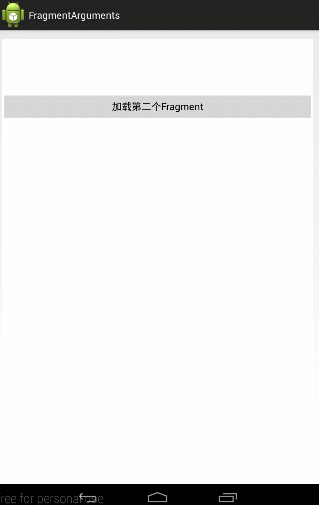Fragment跳轉時傳遞引數及結果回傳的方法
前言:不知不覺工作已經八個月了,深感沒學到什麼東西啊,今年要努力了。但以後真的會用到android技術嗎,根本回答不了這個問題,只能說,它是一個在任何事情都不成功的情況下,保命的根本而已,但技術還是要深通的。利用這兩年時間把android搞精搞透。加油吧,少年
今天總結一下Fragment間的引數傳遞及結果返回的方法。
效果圖:
1、點選“載入第二個Fragment按鈕”,加載出第二個Fragment,同時傳遞過去引數:“從Fragment1傳來的引數”這幾個String;
2、當用戶點選第二個Fragment中的幾個圖片時,將點中的結果返回給第一個Fragment,將使用者的選擇在第一個Fragment顯示出來
一、基本架構搭建
首先,我們要把整個架構搭起來,然後再進行引數傳遞和回傳
(一)、基本XML構建:
根據上面的效果,大家很容易看到兩個Fragment的佈局:
1、Fragment1的佈局:(fragment1.xml)
很簡單,垂直佈局,上面一個ImageView來盛裝返回過來的圖片結果,下面一個Button來用來點選載入第二個Fragment;
2、Fragment2的佈局:(fragment2.xml)<LinearLayout xmlns:android="http://schemas.android.com/apk/res/android" android:layout_width="match_parent" android:layout_height="match_parent" android:background="#ffffff" android:orientation="vertical"> <ImageView android:id="@+id/img_result" android:layout_width="100dp" android:layout_height="100dp" android:scaleType="center"/> <Button android:id="@+id/load_fragment2_btn" android:layout_width="fill_parent" android:layout_height="wrap_content" android:text="載入第二個Fragment"/> </LinearLayout>
這個也是垂直佈局,上面的一個TextView用來盛裝從Fragment1傳過來的String引數,下面的幾個ImageView用來顯示幾個供使用者選擇的圖片
<LinearLayout xmlns:android="http://schemas.android.com/apk/res/android" android:layout_width="match_parent" android:layout_height="match_parent" android:background="#ffffff" android:orientation="vertical"> <TextView android:id="@+id/textview" android:layout_width="wrap_content" android:layout_height="wrap_content" android:text="This is fragment 2" android:textColor="#000000" android:textSize="25sp" /> <ImageView android:id="@+id/img1" android:layout_width="100dip" android:layout_height="100dp" android:scaleType="center" android:src="@drawable/animal1"/> <ImageView android:id="@+id/img2" android:layout_width="100dip" android:layout_height="100dp" android:scaleType="center" android:src="@drawable/animal2"/> <ImageView android:id="@+id/img3" android:layout_width="100dip" android:layout_height="100dp" android:scaleType="center" android:src="@drawable/animal3"/> <ImageView android:id="@+id/img4" android:layout_width="100dip" android:layout_height="100dp" android:scaleType="center" android:src="@drawable/animal4"/> </LinearLayout>
(二)對應的Fragment類
1、在MainActivity初始化時,將Fragment1顯示出來:
MainActivity對應的XML檔案:(main_activity.xml)
<RelativeLayout xmlns:android="http://schemas.android.com/apk/res/android"
xmlns:tools="http://schemas.android.com/tools"
android:id="@+id/main_layout"
android:layout_width="match_parent"
android:layout_height="match_parent"
tools:context=".MainActivity">
<TextView
android:text="@string/hello_world"
android:layout_width="wrap_content"
android:layout_height="wrap_content" />
</RelativeLayout>public class MainActivity extends Activity {
@Override
protected void onCreate(Bundle savedInstanceState) {
super.onCreate(savedInstanceState);
setContentView(R.layout.activity_main);
Fragment1 fragment1 = new Fragment1();
getFragmentManager().beginTransaction().replace(R.id.main_layout, fragment1).commit();
}
}2、Fragment1:在使用者點選時,將fragment2新增到當前頁面顯示出來;
public class Fragment1 extends Fragment {
@Override
public View onCreateView(LayoutInflater inflater, ViewGroup container,
Bundle savedInstanceState) {
View view = inflater.inflate(R.layout.fragment1, container, false);
Button btn = (Button)view.findViewById(R.id.load_fragment2_btn);
btn.setOnClickListener(new View.OnClickListener(){
@Override
public void onClick(final View view) {
Fragment2 fragment2 = new Fragment2();
FragmentTransaction transaction = getFragmentManager().beginTransaction();
transaction.add(R.id.main_layout, fragment2);
transaction.addToBackStack(null);
transaction.commit();
}
});
return view;
}
}3、Fragment2:至於目前的它還是很簡單的,只要能顯示出來 就好了,所以他的程式碼為:
public class Fragment2 extends Fragment implements View.OnClickListener {
@Override
public View onCreateView(LayoutInflater inflater, ViewGroup container, Bundle savedInstanceState) {
View view = inflater.inflate(R.layout.fragment2, container, false);
return view;
}
}
二、Fragment間引數傳遞
在Fragment2中,新建一個函式:newInstance(String text)來接收傳過來的引數:
新建一個Fragment2例項,然後將引數通過SetArguments設定到其中;
public static Fragment2 newInstance(String text) {
Fragment2 fragment = new Fragment2();
Bundle args = new Bundle();
args.putString("param", text);
fragment.setArguments(args);
return fragment;
} public View onCreateView(LayoutInflater inflater, ViewGroup container, Bundle savedInstanceState) {
View view = inflater.inflate(R.layout.fragment2, container, false);
if (getArguments() != null) {
String mParam1 = getArguments().getString("param");
TextView tv = (TextView)view.findViewById(R.id.textview);
tv.setText(mParam1);
}
return view;
}public class Fragment1 extends Fragment {
@Override
public View onCreateView(LayoutInflater inflater, ViewGroup container,
Bundle savedInstanceState) {
View view = inflater.inflate(R.layout.fragment1, container, false);
Button btn = (Button)view.findViewById(R.id.load_fragment2_btn);
btn.setOnClickListener(new View.OnClickListener(){
@Override
public void onClick(final View view) {
Fragment2 fragment2 = Fragment2.newInstance("從Fragment1傳來的引數");
FragmentTransaction transaction = getFragmentManager().beginTransaction();
transaction.add(R.id.main_layout, fragment2);
transaction.addToBackStack(null);
transaction.commit();
}
});
return view;
}
}
